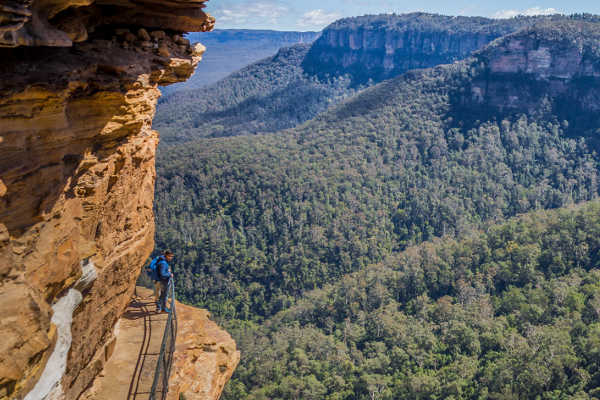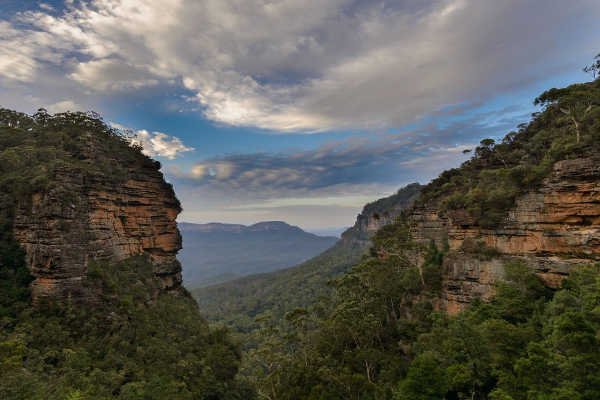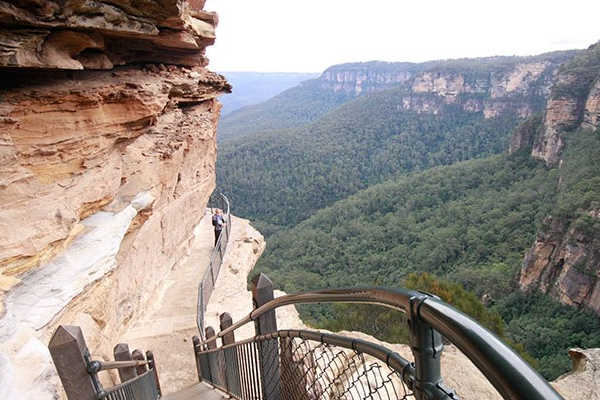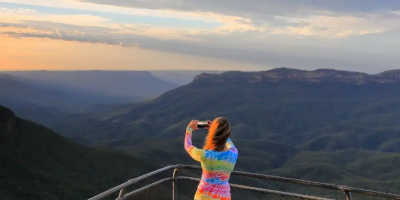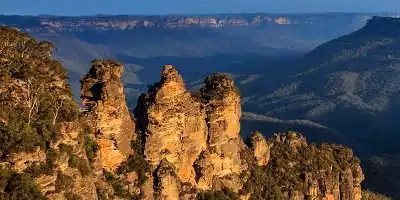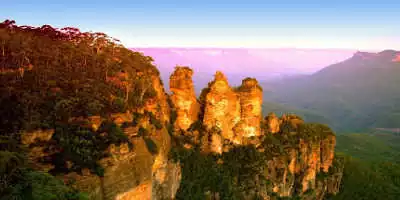Jamison Valley, New South Wales
Katoomba, New South Wales 2780
Located amongst the velvet scenery of the Blue Mountains, the Jamison Valley makes up a part of the Coxs River system, a complex structure of canyons and valleys that sprawl out in New South Wales.
You can travel there from Sydney, which is around 100km away, and the valley lies just a few kilometres from Katoomba, a popular hotspot within the Blue Mountains. Jamison Valley proves to be a popular point for tourists because it boasts breath-taking views and natural landscapes, as well as a rich history and a plethora of things to do.
How was Jamison Valley created?
The historic timeline of the Blue Mountains spans back thousands of years, 470 million years to be exact. The development of the region began when the entire land was immersed in seawater. With the earth’s plates slowly moving to create the continents we know today. During this time, the large sediments settled on the seafloor. Slowly compressing together to form sandstone and shale underwater rocks. Once the sea levels lowered, the large rocks appeared; with thousands of years of erosion and volcano eruptions shaping these mountains. Soon life developed, covering the area in rich greenery and unique Australian animals. Creating what we know today, as the green Jamison Valley.
Jamison Valley is primarily made out of sandstone and is characterised by its steep cliffs and eucalyptus bound forest. It’s what lies underneath the soil where you’ll find the reason for these canyons and valleys. Shale is a sedimentary rock that is a soft material which when erodes, brings the sandstone down with it and creates rifts in the land. During the 1850s the Blue Mountains area was used mainly for mining coal and oil shale, as well as logging. Nowadays, the Blue Mountains heavily relies on the tourism industry and the road and tracks once used by miners are now popular bushwalking trails.
The Ancient Aboriginals of the Land
During the ancient times of the Blue Mountains, the first humans to appear in the region where the Aboriginal community. Due to the size of the country, hundreds of separate tribes inhabited the area, each with their own culture and territory. Two major tribes inhabited the Blue Mountains, known as the Gundungurra, Darug Tribes, and the Burra Burra tribe. The Jamison Valley is thought to have been owned by the local Aboriginal Gundungurra peoples, who are rumoured to have resided in the area for almost 50,000 years.
The Events of the European Invasion
Even after the complete European invasion of Australia, the Blue Mountains remained a wild terrain for many years. This was all due to the jagged rocks, steep ground, and thick forestland, making urban development impossible. With the region soon attaining a reputation for being impenetrable. This was until the trio made up of Gregory Blaxland, William Charles Wentworth, and Lieutenant Lawson formed an exploration group in 1813. They went in search of accessible land, exploring the region and enduring numerous hardships. The team were about to give up until they came across a gentle slope along the Mountains. Which offered a simpler path to the topmost regions.
The History of Jamison Valley
The valley got its name from a prominent landowner who regularly visited the Blue Mountains in the 18th and 19th centuries, Jamison Valley – Blue Mountains and it’s been known to have hosted a few famous faces throughout the years – Charles Darwin is thought to have visited the region when the local towns started to be developed. Stories say that he revelled in the views of Jamison Valley, and there’s now even a walk now named after him that takes in Wilson Park, Wentworth Falls, and Jamison Creek.
Things to do in Jamison Valley
Thanks to its incredible mountain scenery, the Jamison Valley is best-known for its selection of bushwalks that sprawl out through the dense forests, past natural phenomena, and amongst awe-inspiring panoramas. For the adrenaline seekers, why not try abseiling at nearby Malaita Point near Scenic World or at Castle Head.
-
Hike around the Valley
Across the northern escarpment there are a number of popular hikes, including the Darwin walk, as well as a number of neglected tracks that walkers have been trying to get restored for years.
You can also find a collection of easy, beautiful walks that follow the cliffs near Leura and Katoomba, and then there’s the Federal Pass, a busy route that flows past the foot of the mountains. Bushwalks around the Ruined Castle, Mount Solitary, Kings Tableland, and Wentworth Falls also prove to be hugely popular with active travellers.
-
Camp under the Stars
To make the most out of the experience, you can camp all around the area, which provides sheltered hotspots to set up your tent and soak up the scenery. Whether you decide to camp or not, though, Jamison Valley is the perfect place to get up close and personal with Australia’s fantastic natural landscape.
-
Abseil above the Canopy
If you crave adventure, abseiling is an activity that lets you marvel at the picturesque region while getting your adrenaline pumping. The most popular destination to abseil from is Malaita Point and Malaita Wall. Letting visitors descend straight into the valley, showcasing the impressive wildlife below.
-
Dip in the Fresh Water
It’s not just forest that covers the region, but a number of impressive water spectacles. Jamison Valley is lined with waterways, rivers and waterfalls, all thousands of years old. There are multiple water spots to choose from, with Jamison Creek, Gordons Creek, Causeway Creek and Kedumba River just a few of the choices. Many of the water attractions are home to epic lookout points and unique wildlife. Including the mysterious platypus which is one of the hardest animals to see in the wild. There are even a couple that allows swimming, so bring along your bathers and plunge into the crystal-clear waters.
Best Walks in the Jamison Valley
-
Castle Head
This easy to moderate walks will take you through gorgeous views of Lake Burragorang, Mt Solitary and the Jamison Valley all from the Castle Head Lookout on the Narrow Neck Peninsula. In total, it’s around 6 kilometres and a 2-hour walk. From the lookout, you’ll even get a sight of the iconic Three Sisters rock formation, as well as the Ruined Castle. This walk begins in Katoomba, a well-known suburb that is popular with tourists, home to many lookouts. At the top of the Castle Head lookout, the frontal view is of Mt Solitary, the lone mountain the Jamison Valley. To the right of the mountain, you’ll spot in the distance the crystal blue waters of Lake Burragorang, and to the left, the hazy image of the Three Sisters.
-
National Pass
Easily one of the most popular walks in the Blue Mountains, the National Pass is graded at level 4 meaning it’s a difficult walk and covers a trail of about 4.6 kilometres. It should take around 2-4 hours to complete and has an ascension of 290 metres. The trail was first opened in 1908 and since then has become one of the more iconic walking circuits in the Blue Mountains region thanks to its sweeping views of Jamison Valley and Wentworth Falls. This walk can be taken any time of the year as most of it is covered under the canopy and some highlights include waterfalls, cliffs and valley views.
The walk begins at Conservation Hut, a hut first opened in 1963 acting as a meeting place for those in the conservation movement. In 1993, the Conservation Hut re-opened as a café and now serves breakfast, lunch and dinner. From there, you pass through the Valley of the Waters and some impressive lookouts before you get to the first waterfall; Empress Falls. The next waterfall in the Valley of Waters is Lodore Falls, prettily stacked falls that have a staircase running down the side so that you can get a view of the waterfall from top to bottom. After the magnificent journey of discovering magical waterfalls and impressive lookouts, you’ll return to the Conservation hut where you can refuel with dinner.

